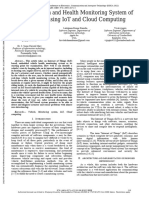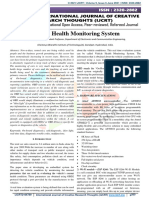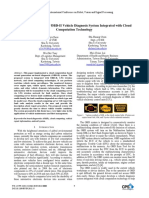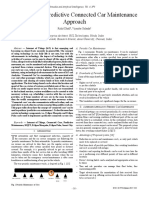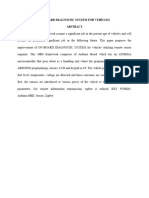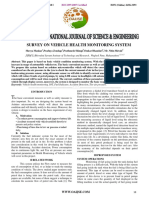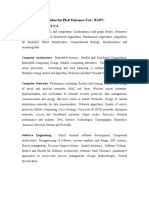International Journal of Recent Technology and Engineering (IJRTE)
ISSN: 2277-3878 (Online), Volume-10 Issue-3, September 2021
A Real Time Implementation of an IOT based
Vehicle Health Monitoring System
Hirakjyoti Sarma, Dimpal Huzuri, Manoj Kumar Deka
Abstract: This paper approaches an IoT based vehicle health As a result, service capacity, efficiency of maintenance
monitoring system that is embedded for detecting the condition of and operations of vehicles are also improved. Besides, the
a vehicle by monitoring the internal parameters such as heating operating and maintenance cost of the vehicle are reduced
rate, engine oil level and status of the CO of the vehicle. It is a
real time vehicle health monitoring system is designed and and minimize the troubleshooting by almost half. This
developed to detect and identify the actuator and sensor faults model can be implemented to identify and report he faults
created by automatically or manually by the user of the vehicle. in a vehicle to the authorized service centre through
Actually, Vehicles need repair after a certain interval of time and wireless communication which is a concept of remote
if are not repaired at fixed intervals, it can lead to loss of life of diagnostics.
the persons travelling on it and there are many key issues which
can affect the vehicle. So, the primary objective of this system is
developing an IoT based embedded system that can detect the II.SYSTEM ARCHITECHTURE
internal condition of a vehicle by evaluating the various This system comprises of both the hardware design and
parameters that are used to examine in the vehicle’s current
the software implementation as a package. Software part is
health condition. In fact, this is a real time evaluation system that
can be used for rapid condition screening. As a result, it provides a web based application that is used for notifying the user
all reliable information about the vehicle conditions. This IoT and manufacturer about the fault in the vehicle that needs to
based system claims that it can detect and identify actuator and be repaired.
sensor faults with almost minimal detection latency even after A. Hardware Module
lots of disturbances and uncertainties. As per the hardware part is concerned, the
Index Terms: Sensor, IoT, Vehicle Health Monitoring, Real
SST89E516RD2 Microcontroller enables working of the
Time, Actuator Faults. entire circuit through DC power supply. For detecting the
temperature and continuously sends the readings to the
I.INTRODUCTION Microcontroller in real time, a temperature sensor is
employed in the hardware interface of the monitoring
This approach defines a real time system for detecting system,
the vehicle condition by monitoring the various inner
parameters of a vehicle such as Heating Rate, Fuel Level
and status of the CO of the vehicle that are used in
evaluating the actuator and sensor faults of the vehicles i.e.
current health condition. The objective of the system is to
notify the users about the excessive heating of the engine,
fuel level and status of Carbon Monoxide (CO). A
temperature sensor is connected in the engine that gives an
alarm the user about overheating of engine. Besides, a
voltage divider is used to measure the fuel level while a
MQ7 based sensor is also employed in the engine that can
identify the status of CO. This helps in proper monitoring
and evaluating the performance of the vehicle [2]. If the
vehicles are monitored, the reliability of vehicles is
increased.
Manuscript received on July 29, 2021.
Revised Manuscript received on September 15, 2021. Fig. 1. Block Diagram of Hardware Interface of the
Manuscript published on September 30, 2021.
*
Correspondence Author
Vehicle Health Monitoring System
Dr. Hirakjyoti Sarma*, Gauhati University Institute of Science and Other then, two sensors are engaged in the engine. The
Technology, Gauhati University, Guwahati, (Assam), India. Email: fuel level sensor detects the engine oil level and its
hirakjyoti@gauhati.ac.in functionality is like a voltage divider mechanism which is
Dimpal Huzuri, Department of Information Technology, Gauhati
University, Guwahati, (Assam), India. Email: dimpalhuzuri9@gmail.com used to measure the engine oil level in real time. A MQ7
Dr. Manoj Kumar Deka, Department of Computer Science and based CO sensor is applied in the engine to detect whether
Technology, Bodoland University, Kokrajhar, (Assam), India. Email: CO level is high or Normal.
manoj.deka1@gmail.com
© The Authors. Published by Blue Eyes Intelligence Engineering and
Sciences Publication (BEIESP). This is an open access article under the CC
BY-NC-ND license (http://creativecommons.org/licenses/by-nc-nd/4.0/)
Published By:
Retrieval Number: 100.1/ijrte.C63380910321 Blue Eyes Intelligence Engineering
DOI: 10.35940/ijrte.C6338.0910321 and Sciences Publication (BEIESP)
Journal Website: www.ijrte.org 140 © Copyright: All rights reserved.
� A Real Time Implementation of an IOT based Vehicle Health Monitoring System
The information is continuously being updated on the
internet through an ESP8266 Wi-Fi module that is attached
to the Microcontroller and can monitor the data on LCD
display. The Wi-Fi module uses a network of IoT to send
the data to the server and also to access the data from the
server. An update notification is also sent to the webpage by
the web server whenever temperature rises, engine oil level
and CO status is observed using Wi-Fi module through a
network of IoT.
B. Server Module
The cloud module present in this system provides a
graphical user interface designed for user services and
maintenance of data received by the web server. This cloud
module will function in two ways, the first one is front end
application of a webpage and the other one is database for
storing and retrieving the data in real time.
At front end, the system will take the responsibility for
creating user’s profile in database with unique user key.
This module is all about the web server that is configured to
handle responses from the ESP8266 Wi-Fi module and
requests sent by the user through a server site programming Fig. 2. Circuit Diagram
written in PhP. The programming is responsible for
collecting the data that is transmitted through a router over A. Circuit Design
Wi-Fi communication and fetch into the database present in The circuit is designed and simulate by proteus
the server. The ESP8266 module has to be configured with simulation software that has a popular 8052 family
the router to connect with the server. When the ESP8266 microcontroller SST89E516RD2 having 40 pin DIP
receives valid information from microcontroller by a serial package. To reduce any noise or ripple we are using two
communication, it will transmit the data to the web server 200 nF ceramic capacitor across pin no. 1 & 2 and 2& 3.
that is configured by the configuration of ESP8266 Any micro-controller or micro-processor require clock
Attention (AT) command. This data can be used for further source to fetch instructions and execute if few micro-
use like online monitoring, performance analysis etc. controller has internal oscillator but SST89E516RD2 is not
Later on, the system will create and maintain the having any internal oscillator. Hence this circuit must have
details of devices and the operations performed on it to use external oscillator circuit. To provide clock source
according to the user’s specification. At back end, the data the switching circuit can use crystal oscillator, resonator,
received from gateway is stored according to the user’s
function generator or even another micro-controller. The
specific instruction and their devices and the data is
visualized under device data in user profiles. crystals are most commonly used oscillator for micro-
controller pin 18 & 19 of SST89E516RD2 are XTAL1
III. IMPLEMENTATION &XTAL2 respectively.
As per the capacity SST89E516RD2 can operate from 0
The primary objective of the system is to identify or MHz to 33 MHz. i.e. we can use a crystal oscillator of value
detect various parameters associated with a conventional (0-33) MHz. In this circuit, systems are using 11.0592 MHz
vehicle or electrical vehicle. In this system, a special focus crystal.
has given on three vital parameter i.e. temperature of the This odd no. is very important in case of serial
engine, oil level and carbon monoxide. The system will communication if there is noneed to do
keep monitoring these parameters and transmit the data to serial communication then system can go with any crystal
the web server using Wi-Fi communication, so that this frequency (0-33) MHz, but if serial communication is
information can be used by different group of people or user needed then, system must have to use 11.0592 MHz crystal
Primarily this information can be need by or helpful or otherwise there will be error in serial communication and it
useful for the user of the vehicle, the automobile industry as will not communicate with the external device properly. In
well as government organization like District Transport this work, system must have to implement serial
Office. The primary objectives or the features of the system communication, as the Wi-Fi module ESP8266
are microcontroller based designing for flexibility and communicate with micro-controller through serial
upgradability. It enables transmission of data over secured communication only. Parallel to the crystal i.e at pin no. 18
Wi-Fi communications. Cloud based server or a web server & 19 to ceramic capacitor C1 & C2 of value 33PF is
can be used to implement the system. The system connected to ground.
Implements of free work and widely used software in web
technology for higher acceptance.
Published By:
Retrieval Number: 100.1/ijrte.C63380910321 Blue Eyes Intelligence Engineering
DOI: 10.35940/ijrte.C6338.0910321 and Sciences Publication (BEIESP)
Journal Website: www.ijrte.org 141 © Copyright: All rights reserved.
� International Journal of Recent Technology and Engineering (IJRTE)
ISSN: 2277-3878 (Online), Volume-10 Issue-3, September 2021
To measure the temperature, system uses digital
temperature sensor DS18B20, it is having internal ADC and
provide data in digital form and hence we don’t need any
external ADC, DS18B20 communicate with the micro-
controller using 1 wire communication protocol i.e only one
I/O pin is used to send command from micro-controller to
DSB18B20 and read the data through the same pin. To
measure the fuel level system uses the mechanism of
voltage divider. As the voltage divider circuit follows
Vout= (R1/R1+R2)*Vin. Where, R1 & R2 change the
output voltage where Vin is fixed. The center terminal is
connected to the MSP3204 which is a 12 bit analog to
digital convertor because the voltage is analog signal and
that’s why it cannot directly measure by micro-controller. It Fig. 3. The Entire System
communicates with the micro-controller or host with a SPI Once the server machine is started after connecting and
protocol that need four signal line i.e. MISO, MOSI, CLK switching the all components required in the system, the
and RST[5]. To identify the status of CO i.e. high or low we data triggering process also is also started from the sensors
are using MQ7 based sensor built on SNO2 and sensitive to present with the vehicle to the database by the
CO. microcontroller over Wi-Fi communication. The data are
B. Data Acquisition stored in the database in the following form of table of
In order to achieve a communication between client and different another fields along with parameters to be
server, a user interface web page is built to take request observed.
from clients i.e. the user of the vehicle. The user interface
and the internet front end are connected to a backend
database server. The users can send request to the server
through the web page to interact with the system. The
request sent by the client is received by the server and
similarly the server acknowledges the client through a
router over Wi-Fi communication. The database is the main
back end present in the web server as a special focus is
given for designing the database as a common integrated
platform to store the instructions sent by the user through
web page. Basically, the database is integrating the platform
between the storage of data from the sensors connected with
the circuit and acquisition of data from the web server. The
database is connected to MySQL server by using a data
source name (DSN). The programming burnt into the Fig. 3. Details of Data received from server
microcontroller is also such way designed that it can trigger The entire system is designed for collecting and
the data collected from the vehicle in real time to the retrieving the real-time data of Temperature, Engine Oil
database. The data are consumed by the sensors that are Level and CO status of the vehicle. So, Administrator and
transferred to the server by a microcontroller AT89S52 users can access the data in real time using the Real time
through a router over WiFi communication after a fixed Monitor option present in the graphical user interface
amount of time repeatedly and stored into the database designed for the client. The real time data for a particular
simultaneously. If any exception is happened on data, then vehicle can be visualized in fig. 4.
it will be sent to the owner of the vehicle [6]. The CO level is
identified by the system as high or low and when it is high,
a buzzer will be rung until the CO becomes low.
IV.RESULT AND ANALYSIS
A few experimental results have been found during the
execution of the system by which user can evaluate and
analysis the performance of the vehicle as mentioned in the
objective of the proposed system, the aim of this work is to
monitor different parameters of vehicle i.e. temperature, oil
level and CO status of a vehicle through IoT connectivity.
The result of this system that is outcome finally can be Fig. 4. Real Time data acquired from a vehicle
visualized with the help of the graphical user interfaces of
present in the server locally and at the client side remotely.
Published By:
Retrieval Number: 100.1/ijrte.C63380910321 Blue Eyes Intelligence Engineering
DOI: 10.35940/ijrte.C6338.0910321 and Sciences Publication (BEIESP)
Journal Website: www.ijrte.org 142 © Copyright: All rights reserved.
� A Real Time Implementation of an IOT based Vehicle Health Monitoring System
V. CONCLUSION Dr. Manoj Kumar Deka, received the M.Sc. degree
in Instrumentation in the year 2007 and Ph.D. degree
The project is initiated by collecting and gathering the in Signal Processing in the year 2011 from Gauhati
information required for evaluating various parameters of University, Assam. He achieved INSPIRE
Fellowship sponsored by Department of Science &
the vehicle health condition. This information includes the Technology (DST), Govt. of India, New Delhi
of vehicles performance on various parameters of car during his Ph.D. work. Presently he is working as
subsystems. Also different methods for health monitoring, Assistant Professor in the Department of Computer
which differ by the way of extraction of parameter values, Science & Technology, Bodoland University,
Assam. His area of interest includes Signal Processing, Embedded system,
are observed regarding their feasibility and economic Artificial Intelligence.
factors.
REERENCES
1. Md. Syedul Amin, Jubayer Jalil, M. B. I. Reaz
2. “Accident Detection and Reporting System using GPS, GPRS and
GSM Technology”, ICIEV on 18-19 May, 2012 in dhaka, IEEE 978-
1-4673-1154-0/1
3. D.B. Tushara and P. A. H. Vardhini, "Wireless vehicle alert and
collision prevention system design using Atmel microcontroller,"
2016 International Conference on Electrical, Electronics, and
Optimization Techniques (ICEEOT), Chennai, 2016, IEEE 978-1-
4673-9939,pp-2784-2787
4. T. Shwetha1, J. Panduranga Rao2, B. Sreenivasu3, “IoT based
Driver Alertness And Health Monitoring System”, ISSN: 2278 –
909X International Journal of Advanced Research in Electronics and
Communication Engineering (IJARECE) Volume 6, Issue 10,
October 2017.
5. S. Kumar Reddy Mallidi Department of CSE VLITS Guntur, India,
V. V. Vineela Department of CSE VLITS Guntur, India, “IoT based
Smart Vehicle Monitoring System” , ISSN No. 0976-5697 Volume
9, No. 2, March-April 2018 International Journal of Advanced
Research in Computer Science.
6. Ebole Alpha F., Prof. Omotosha O. J Lagos State Polytechnic
Ikorodu, Lagos Nigeria Babcock University, Ogun State, Nigeria,
“Vehicle Health Monitoring System In Developing Nation”,
International Journal Of Engineering And Computer Science ISSN:
2319-7242 Volume 3 Issue 5 may, 2014 Page No. 6238-6249.
7. N. Upendra Yadav1, Prof Kamalakannan2 1VIT University,
Vellore, India 2Assistant Professor (Selection Grade, ME, CSE
Department), VIT University, Vellore, India, “Smart Vehicle
Monitoring System using IOT”, IJDCST@March-April-2017,Issue-
V-5,I-3,SW-31 ISSN-2320-7884 (Online) ISSN-2321-0257 (Print).
8. M. Jyothi kiran, S.Ravi teja, Research Scholars of K.L.
University,“Vehicle Health Monitoring System”, International
Journal of Engineering Research and Applications (IJERA) ISSN:
2248-9622 Vol. 2, Issue 5, September- October 2012, pp.1162-1167.
9. Chaitra B1, Raziya Begum M2, Aishwarya K3, Sachin Patil4
1,2,3Student, 4Professor, “Vehicle Health Monitoring System Using
ARDUINO and IOT”, Department of Electronics & communication
Engineering Smt. Kamala & Sri Venkappa M Agadi College of
Engineering and Technology, International Journal on Recent and
Innovation Trends in Computing and Communication, May,
2017,Vol.5, Issue 5, ISSN 2321-8169, pp – 252-254.
AUTHOR PROFILE
Dr. Hirakjyoti Sarma is presently working as an
assistant Professor at Gauhati University Institute of
Science and Technology, Assam, India. He has
completed his B.Tech in CSE and M.Tech in IT
from Gauhati University, Assam, India in 2011 and
2013 respectively. He has completed his Ph.D.
Degree from Bodoland University, Assam, India in
2020. Area of Interest – Embedded System, Internet of things, Operating
System, Computer Vision.
Dimpal Huzuri presently working as an IoT and
Web based project developer in a private sector.He
completed his B. Tech from Gauhati
University,Assam on Information Technology in
2019.He has experience of more than 2 years of
academic/research/Industry. Area of Interest -web
development, cloud computing, wireless security,
internet of things, computer network security.
Published By:
Retrieval Number: 100.1/ijrte.C63380910321 Blue Eyes Intelligence Engineering
DOI: 10.35940/ijrte.C6338.0910321 and Sciences Publication (BEIESP)
Journal Website: www.ijrte.org 143 © Copyright: All rights reserved.


